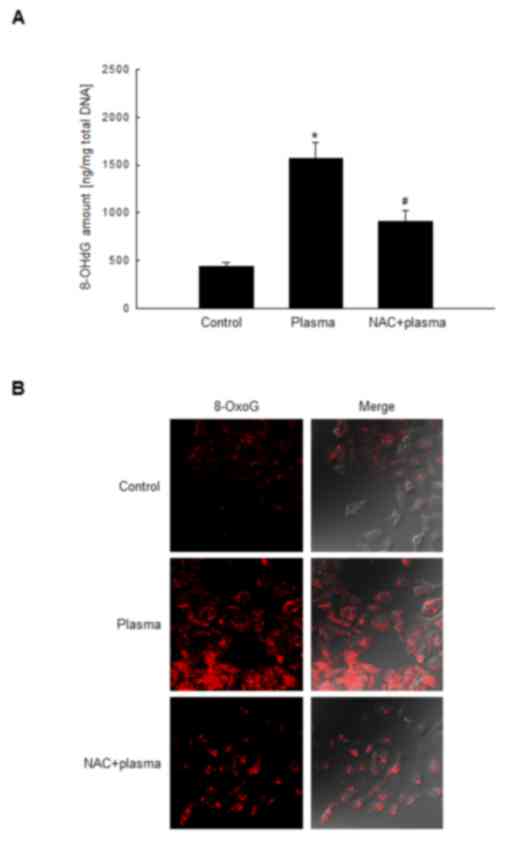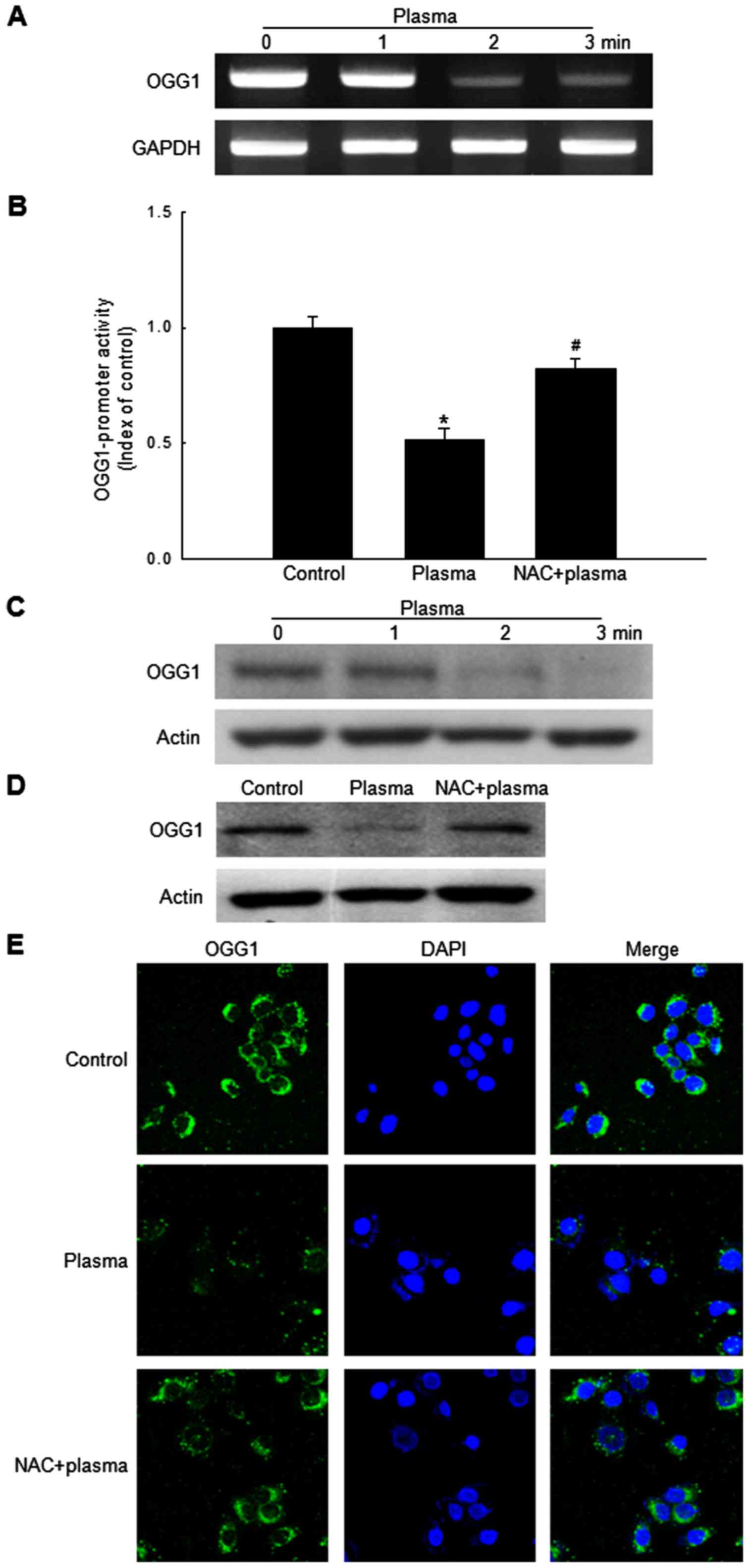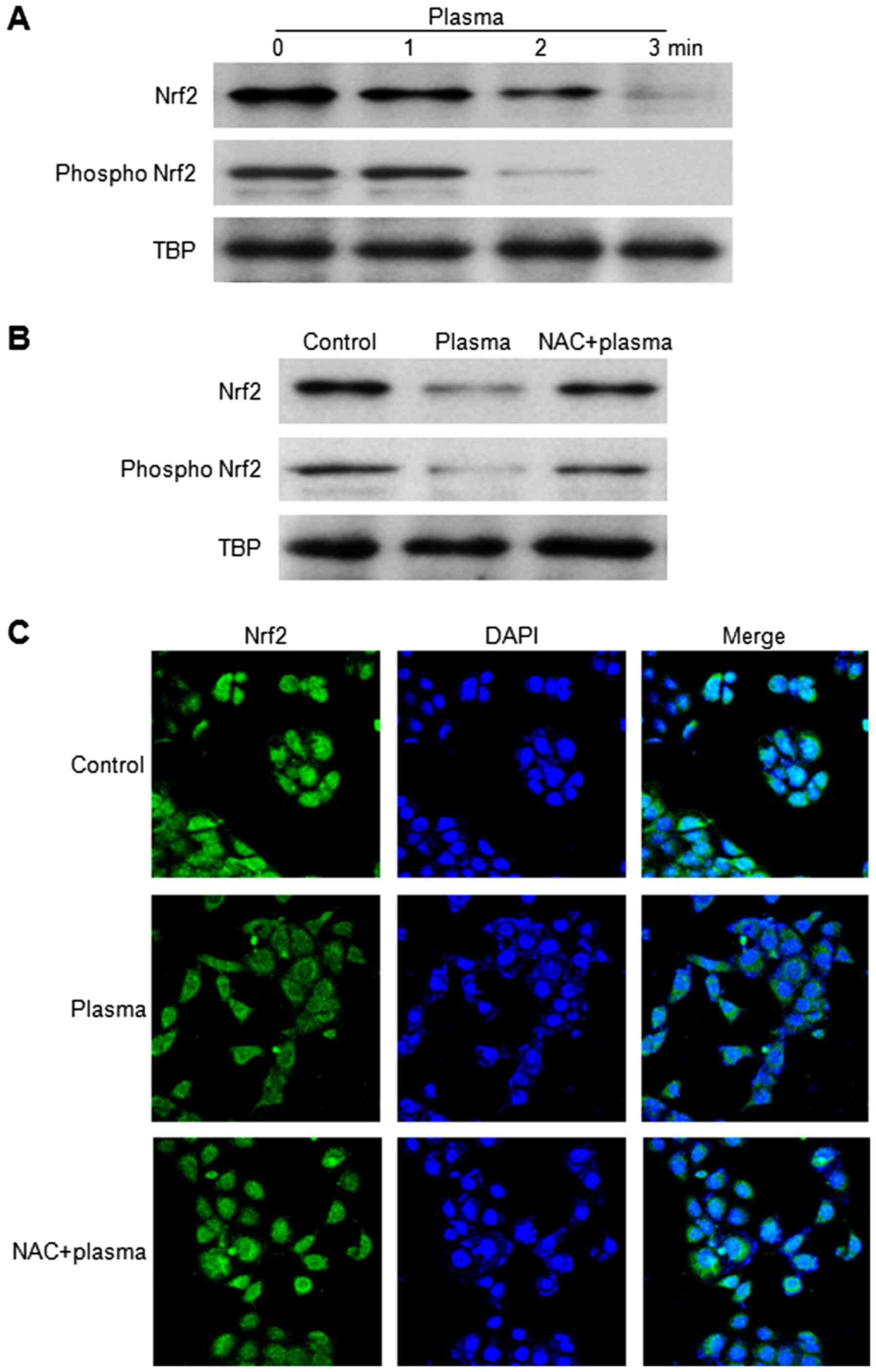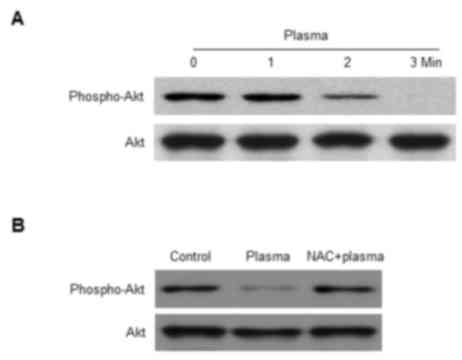|
1
|
Fortini P, Pascucci B, Parlanti E,
D'Errico M, Simonelli V and Dogliotti E: 8-Oxoguanine DNA damage:
At the crossroad of alternative repair pathways. Mutat Res.
531:127–139. 2003. View Article : Google Scholar : PubMed/NCBI
|
|
2
|
Bruner SD, Norman DP and Verdine GL:
Structural basis for recognition and repair of the endogenous
mutagen 8-oxoguanine in DNA. Nature. 403:859–866. 2000. View Article : Google Scholar : PubMed/NCBI
|
|
3
|
Nakabeppu Y: Cellular levels of
8-oxoguanine in either DNA or the nucleotide pool play pivotal
roles in carcinogenesis and survival of cancer cells. Int J Mol
Sci. 15:12543–12557. 2014. View Article : Google Scholar : PubMed/NCBI
|
|
4
|
Görgens H, Müller A, Krüger S, Kuhlisch E,
König IR, Ziegler A, Schackert HK and Eckelt U: Analysis of the
base excision repair genes MTH1, OGG1 and MUTYH in patients with
squamous oral carcinomas. Oral Oncol. 43:791–795. 2007. View Article : Google Scholar : PubMed/NCBI
|
|
5
|
Klungland A, Rosewell I, Hollenbach S,
Larsen E, Daly G, Epe B, Seeberg E, Lindahl T and Barnes DE:
Accumulation of premutagenic DNA lesions in mice defective in
removal of oxidative base damage. Proc Natl Acad Sci USA.
96:13300–13305. 1999; View Article : Google Scholar : PubMed/NCBI
|
|
6
|
Boiteux S and Radicella JP: The human OGG1
gene: Structure, functions, and its implication in the process of
carcinogenesis. Arch Biochem Biophys. 377:1–8. 2000. View Article : Google Scholar : PubMed/NCBI
|
|
7
|
De S, ouza-Pinto NC, Eide L, Hogue BA,
Thybo T, Stevnsner T, Seeberg E, Klungland A and Bohr VA: Repair of
8-oxodeoxyguanosine lesions in mitochondrial dna depends on the
oxoguanine dna glycosylase (OGG1) gene and 8-oxoguanine accumulates
in the mitochondrial dna of OGG1-defective mice. Cancer Res.
61:5378–5381. 2001.PubMed/NCBI
|
|
8
|
Sampath H, McCullough AK and Lloyd RS:
Regulation of DNA glycosylases and their role in limiting disease.
Free Radic Res. 46:460–478. 2012. View Article : Google Scholar : PubMed/NCBI
|
|
9
|
Singh B, Chatterjee A, Ronghe AM, Bhat NK
and Bhat HK: Antioxidant-mediated up-regulation of OGG1 via NRF2
induction is associated with inhibition of oxidative DNA damage in
estrogen-induced breast cancer. BMC Cancer. 13:2532013. View Article : Google Scholar : PubMed/NCBI
|
|
10
|
Luo QZ, D'Angelo N and Merlino RL: Shock
formation in a negative ion plasma. Phys Plasmas. 5:28681998.
View Article : Google Scholar
|
|
11
|
Goree J: Charging of particles in a
plasma. Plasma Sources Sci Technol. 3:4001994. View Article : Google Scholar
|
|
12
|
Leduc M, Guay D, Leask RL and Coulombe S:
Cell permeabilization using a non-thermal plasma. New J Phys.
11:1150212009. View Article : Google Scholar
|
|
13
|
Kalghatgi S, Friedman G, Fridman A and
Clyne AM: Endothelial cell proliferation is enhanced by low dose
non-thermal plasma through fibroblast growth factor-2 release. Ann
Biomed Eng. 38:748–757. 2010. View Article : Google Scholar : PubMed/NCBI
|
|
14
|
Ermolaeva SA, Varfolomeev AF, Chernukha
MY, Yurov DS, Vasiliev MM, Kaminskaya AA, Moisenovich MM, Romanova
JM, Murashev AN, Selezneva II, et al: Bactericidal effects of
non-thermal argon plasma in vitro, in biofilms and in the animal
model of infected wounds. J Med Microbiol. 60:75–83. 2011.
View Article : Google Scholar : PubMed/NCBI
|
|
15
|
Vandamme M, Robert E, Lerondel S, Sarron
V, Ries D, Dozias S, Sobilo J, Gosset D, Kieda C, Legrain B, et al:
ROS implication in a new antitumor strategy based on non-thermal
plasma. Int J Cancer. 130:2185–2194. 2012. View Article : Google Scholar : PubMed/NCBI
|
|
16
|
Ahn HJ, Kim KI, Kim G, Moon E, Yang SS and
Lee JS: Atmospheric-pressure plasma jet induces apoptosis involving
mitochondria via generation of free radicals. PLoS One.
6:e281542011. View Article : Google Scholar : PubMed/NCBI
|
|
17
|
Arjunan KP and Clyne AM: Non-thermal
dielectric barrier discharge plasma induces angiogenesis through
reactive oxygen species. Conf Proc IEEE Eng Med Biol Soc.
2011:2447–2450. 2011; PubMed/NCBI
|
|
18
|
Ishaq M, Kumar S, Varinli H, Han ZJ, Rider
AE, Evans MD, Murphy AB and Ostrikov K: Atmospheric gas
plasma-induced ROS production activates TNF-ASK1 pathway for the
induction of melanoma cancer cell apoptosis. Mol Biol Cell.
25:1523–1531. 2014. View Article : Google Scholar : PubMed/NCBI
|
|
19
|
Kim KC, Piao MJ, Hewage SR Madduma, Han X,
Kang KA, Jo JO, Mok YS, Shin JH, Park Y, Yoo SJ and Hyun JW:
Non-thermal dielectric-barrier discharge plasma damages human
keratinocytes by inducing oxidative stress. Int J Mol Med.
37:29–38. 2016. View Article : Google Scholar : PubMed/NCBI
|
|
20
|
Struthers L, Patel R, Clark J and Thomas
S: Direct detection of 8-oxodeoxyguanosine and 8-oxoguanine by
avidin and its analogues. Anal Biochem. 255:20–31. 1998. View Article : Google Scholar : PubMed/NCBI
|
|
21
|
Heo HJ, Kim HK, Youm JB, Cho SW, Song IS,
Lee SY, Ko TH, Kim N, Ko KS, Rhee BD and Han J: Mitochondrial
pyruvate dehydrogenase phosphatase 1 regulates the early
differentiation of cardiomyocytes from mouse embryonic stem cells.
Exp Mol Med. 48:e2542016. View Article : Google Scholar : PubMed/NCBI
|
|
22
|
Hazra TK, Izumi T, Boldogh I, Imhoff B,
Kow YW, Jaruga P, Dizdaroglu M and Mitra S: Identification and
characterization of a human DNA glycosylase for repair of modified
bases in oxidatively damaged DNA. Proc Natl Acad Sci USA.
99:3523–3528. 2002; View Article : Google Scholar : PubMed/NCBI
|
|
23
|
Kang KA and Hyun JW: Oxidative stress,
Nrf2 and epigenetic modification contribute to anticancer drug
resistance. Toxicol Res. 33:1–5. 2017. View Article : Google Scholar : PubMed/NCBI
|
|
24
|
Piao MJ, Kim KC, Choi JY, Choi J and Hyun
JW: Silver nanoparticles down-regulate Nrf2-mediated 8-oxoguanine
DNA glycosylase 1 through inactivation of extracellular regulated
kinase and protein kinase B in human chang liver cells. Toxicol
Lett. 207:143–148. 2011. View Article : Google Scholar : PubMed/NCBI
|
|
25
|
Wang L, Chen Y, Sternberg P and Cai J:
Essential roles of the PI3 kinase/Akt pathway in regulating
Nrf2-dependent antioxidant functions in the RPE. Invest Ophthalmol
Vis Sci. 49:1671–1678. 2008. View Article : Google Scholar : PubMed/NCBI
|
|
26
|
Nakabeppu Y, Sakumi K, Sakamoto K,
Tsuchimoto D, Tsuzuki T and Nakatsu Y: Mutagenesis and
carcinogenesis caused by the oxidation of nucleic acids. Biol Chem.
387:373–379. 2006. View Article : Google Scholar : PubMed/NCBI
|
|
27
|
Radicella JP, Dherin C, Desmaze C, Fox MS
and Boiteux S: Cloning and characterization of hOGG1, a human
homolog of the OGG1 gene of Saccharomyces cerevisiae. Proc Natl
Acad Sci USA. 94:8010–8015. 1997; View Article : Google Scholar : PubMed/NCBI
|
|
28
|
Slupska MM, Luther WM, Chiang JH, Yang H
and Miller JH: Functional expression of hMYH, a human homolog of
the Escherichia coli MutY protein. J Bacteriol. 181:6210–6213.
1999.PubMed/NCBI
|
|
29
|
Ohtsubo T, Nishioka K, Imaiso Y, Iwai S,
Shimokawa H, Oda H, Fujiwara T and Nakabeppu Y: Identification of
human MutY homolog (hMYH) as a repair enzyme for 2-hydroxyadenine
in DNA and detection of multiple forms of hMYH located in nuclei
and mitochondria. Nucleic Acids Res. 28:1355–1364. 2000. View Article : Google Scholar : PubMed/NCBI
|
|
30
|
Jung JS, Lee SY, Kim DH and Kim HS:
Protopanaxatriol ginsenoside Rh1 upregulates phase II antioxidant
enzyme gene expression in rat primary astrocytes: Involvement of
MAP kinases and Nrf2/are signaling. Biomol Ther (Seoul). 24:33–39.
2016. View Article : Google Scholar : PubMed/NCBI
|
|
31
|
Kensler TW, Wakabayashi N and Biswal S:
Cell survival responses to environmental stresses via the
Keap1-Nrf2-are pathway. Annu Rev Pharmacol Toxicol. 47:89–116.
2007. View Article : Google Scholar : PubMed/NCBI
|
|
32
|
Sykiotis GP and Bohmann D:
Stress-activated cap'n'collar transcription factors in aging and
human disease. Sci Signal. 3:re32010. View Article : Google Scholar : PubMed/NCBI
|
|
33
|
Boutten A, Goven D, Artaud-Macari E,
Boczkowski J and Bonay M: NRF2 targeting: A promising therapeutic
strategy in chronic obstructive pulmonary disease. Trends Mol Med.
17:363–371. 2011. View Article : Google Scholar : PubMed/NCBI
|


















